by Calculated Risk on 4/30/2012 07:04:00 PM
Monday, April 30, 2012
Restaurant Performance Index increases in March
From the National Restaurant Association: Restaurant Performance Index Closes Out Q1 at Post-Recession High
Driven by solid same-store sales and traffic results and an increasingly bullish outlook among restaurant operators, the National Restaurant Association’s Restaurant Performance Index (RPI) matched its post-recession high in March. The RPI – a monthly composite index that tracks the health of and outlook for the U.S. restaurant industry – stood at 102.2 in March, up 0.3 percent from February and equaling its post-recession high that was previously reached in December 2011.
“The first quarter finished strong with a solid majority of restaurant operators reporting higher same-store sales and customer traffic levels in March,” said Hudson Riehle, senior vice president of the Research and Knowledge Group for the Association. “In addition, restaurant operators are solidly optimistic about sales growth and the economy in the months ahead, which propelled the Expectations component of the RPI to its highest level in 15 months.”
“Bolstered by improving sales and traffic results, restaurant operators’ outlook for capital spending reached its highest level in more than four years,” Riehle added. “This will have positive implications throughout the supply chain of the restaurant industry.”
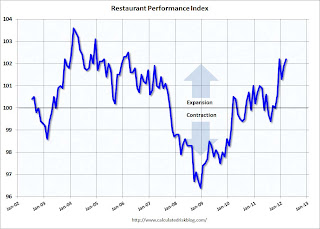 Click on graph for larger image.
Click on graph for larger image.The index increased to 102.2 in March, up from 101.9 in February (above 100 indicates expansion).
Restaurant spending is discretionary, so even though this is "D-list" data, I like to check it every month - and the index was fairly strong in March.
Fannie Mae and Freddie Mac Serious Delinquency rates declined in March
by Calculated Risk on 4/30/2012 04:47:00 PM
Fannie Mae reported that the Single-Family Serious Delinquency rate declined in March to 3.67%, down from 3.82% in February. The serious delinquency rate is down from 4.44% in March 2011, and is at the lowest level since April 2009. Some of the decline over the last two months is seasonal.
The Fannie Mae serious delinquency rate peaked in February 2010 at 5.59%.
Freddie Mac reported that the Single-Family serious delinquency rate declined to 3.51% in March, down from 3.57% in February. Freddie's rate is down from 3.63% in Feburary 2010. Freddie's serious delinquency rate peaked in February 2010 at 4.20%.
These are loans that are "three monthly payments or more past due or in foreclosure".
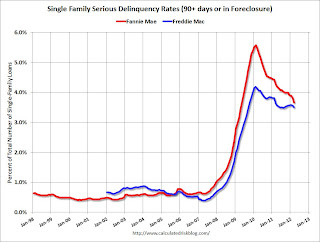 Click on graph for larger image
Click on graph for larger image
With the mortgage servicer settlement, I'd expect the delinquency rate to start to decline faster over the next year or so.
The "normal" serious delinquency rate is under 1%, so there is a long way to go.
Note: LPS reported the serious delinquency rate (including in foreclosore) was about 7.5% in March. That includes the Fannie and Freddie loans with serious delinquency rates at less than half the industry average. This is also a reminder of how bad the non-Fannie/Freddie loans are performing.
Fed: On net, Domestic Banks eased their lending standards and experienced stronger demand over the last 3 months
by Calculated Risk on 4/30/2012 02:27:00 PM
From the Federal Reserve: The April 2012 Senior Loan Officer Opinion Survey on Bank Lending Practices
Overall, in the April survey, modest net fractions of domestic banks generally reported having eased their lending standards and having experienced stronger demand over the past three months. ... However, moderate to large net fractions of domestic banks eased many terms on C&I loans to firms of all sizes, with most indicating that they had done so in response to more aggressive competition from other banks or nonbank lenders. Domestic banks also reported an increase in demand from firms of all sizes.
...
Regarding loans to households, standards on prime residential mortgage loans and home equity lines of credit (HELOCs) were about unchanged. However, the April survey indicated a moderate strengthening in demand for prime residential mortgage loans. With respect to consumer loans, moderate net fractions of banks reported that they had eased standards on most types of these loans over the past three months. In addition, demand for all types of consumer loans increased somewhat, on net, with demand for auto loans showing the largest increase.
 Click on graph for larger image.
Click on graph for larger image.Here are some charts from the Fed.
This graph shows the change in lending standards from the previous quarterly for commercial real estate (CRE). Lenders are now easing standards a little for CRE. A little easing doesn't mean standards are "loose", just not as tight as over the last several years.
 The second graph shows the change in demand for CRE loans.
The second graph shows the change in demand for CRE loans. Increasing demand and some easing in standards - this is another indicator suggesting the drag from non-residential investment will probably end mid-year.
Q1 2012 GDP Details: Office and Mall Investment falls to record low, Single Family investment increases
by Calculated Risk on 4/30/2012 12:25:00 PM
The BEA released the underlying details today for the Q1 Advance GDP report. As expected, key non-residential categories - offices, malls and lodging - saw further declines in investment in Q1.
Note: Last year, there was a small overall increase in non-residential structure investment due to investment for power and communication, and mining and exploration of petroleum. This masked some of the decline in other categories.
The first graph shows investment in offices, malls and lodging as a percent of GDP. Office investment as a percent of GDP peaked at 0.46% in Q1 2008 and then declined sharply.
Investment as a percent of GDP fell to a new low in Q1 and is now down 64% from the peak. This decline will probably slow mid-year based on the architectural billings index, but with the high office vacancy rate, investment will probably not increase (as a percent of GDP) for several years.
 Click on graph for larger image.
Click on graph for larger image.
Investment in multimerchandise shopping structures (malls) peaked in 2007 and is down about 68% from the peak and at a new low in Q1 (note that investment includes remodels, so this will not fall to zero).
Lodging investment peaked at 0.32% of GDP in Q2 2008 and has fallen by about 82%.
Notice that investment for all three categories typically falls for a year or two after the end of a recession, and then usually recovers very slowly (flat as a percent of GDP for 2 or 3 years). This is happening again, and there will not be a recovery in these categories until the vacancy rates fall significantly.
 The second graph is for Residential investment (RI) components as a percent of GDP. According to the Bureau of Economic Analysis, RI includes new single family structures, multifamily structures, home improvement, broker's commissions, and a few minor categories (dormitories, manufactured homes).
The second graph is for Residential investment (RI) components as a percent of GDP. According to the Bureau of Economic Analysis, RI includes new single family structures, multifamily structures, home improvement, broker's commissions, and a few minor categories (dormitories, manufactured homes).
Usually the most important components are investment in single family structures followed by home improvement.
Investment in single family structures is finally increasing after mostly moving sideways for almost three years (the increase in 2009-2010 was related to the housing tax credit).
Investment in home improvement was at a $164 billion Seasonally Adjusted Annual Rate (SAAR) in Q1 (over 1.0% of GDP), significantly above the level of investment in single family structures of $114 billion (SAAR) (or 0.74% of GDP). Eventually single family structure investment will overtake home improvement as the largest category of residential investment.
Brokers' commissions increased slightly in Q1, and has been moving sideways as a percent of GDP.
And investment in multifamily structures increased slightly as a percent of GDP. This is a small category, and even though investment is increasing, the positive impact on GDP will be relatively small.
These graphs show there is currently very little investment in offices, malls and lodging. And residential investment is starting to pickup, but from a very low level.
HVS: Q1 Homeownership and Vacancy Rates
by Calculated Risk on 4/30/2012 10:15:00 AM
The Census Bureau released the Housing Vacancies and Homeownership report for Q1 2012 this morning.
This report is frequently mentioned by analysts and the media to track the homeownership rate, and the homeowner and rental vacancy rates. However, based on the initial evaluation, it appears the vacancy rates are too high.
It might show the trend, but I wouldn't rely on the absolute numbers.
 Click on graph for larger image.
Click on graph for larger image.
The Red dots are the decennial Census homeownership rates for April 1st 1990, 2000 and 2010. The HVS homeownership rate declined to 65.4%, down from to 66.0% in Q4 2011 and at the lowest level for this survey since the mid-90s.
I'd put more weight on the decennial Census numbers and that suggests the actual homeownership rate is probably in the 64% to 65% range.
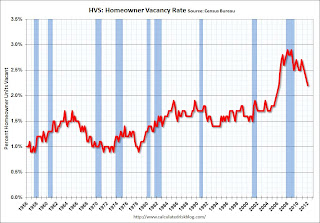 The Census researchers are investigating differences in Census 2010, ACS 2010, and HVS 2010 vacant housing unit estimates, but there is no scheduled date for any report.
The Census researchers are investigating differences in Census 2010, ACS 2010, and HVS 2010 vacant housing unit estimates, but there is no scheduled date for any report.
The HVS homeowner vacancy rate declined to 2.2% from 2.3% in Q4. This is the lowest level since Q2 2006 for this report.
The homeowner vacancy rate has peaked and is now declining. However - once again - this probably shows that the trend is down, but I wouldn't rely on the absolute numbers.
 The rental vacancy rate declined to 8.8% from 9.4% in Q4.
The rental vacancy rate declined to 8.8% from 9.4% in Q4.
I think the Reis quarterly survey (large apartment owners only in selected cities) is a much better measure of the overall trend in the rental vacancy rate - and Reis reported that the rental vacancy rate has fallen to the lowest level since 2001.
The quarterly HVS is the most timely survey on households, but there are many questions about the accuracy of this survey. Unfortunately many analysts still use this survey to estimate the excess vacant supply. However this does suggest that the housing vacancy rates are falling.
Chicago PMI declines to 56.2
by Calculated Risk on 4/30/2012 09:52:00 AM
Chicago PMI: The overall index declined to 56.2 in April, down from 62.2 in March. This was below consensus expectations of 60.8 and indicates slower growth in April. Note: any number above 50 shows expansion. From the Chicago ISM:
April 2012: The Chicago Purchasing Managers reported the April Chicago Business Barometer decreased for a second consecutive month. After five months above 60, the Chicago Business Barometer fell to 56.2, a 29 month low. The index has remained in expansion since October 2009.New orders declined to 57.4 from 63.3, and employment increased to 58.7 from 56.3.
...
• PRODUCTION lowest level since September 2009;
• PRICES PAID down from March's 7 month high;
Personal Income increased 0.4% in March, Spending 0.3%
by Calculated Risk on 4/30/2012 08:42:00 AM
The BEA released the Personal Income and Outlays report for March:
Personal income increased $50.3 billion, or 0.4 percent ... in March, according to the Bureau of Economic Analysis. Personal consumption expenditures (PCE) increased $29.6 billion, or 0.3 percent.The following graph shows real Personal Consumption Expenditures (PCE) through March (2005 dollars). Note that the y-axis doesn't start at zero to better show the change.
...
Real PCE -- PCE adjusted to remove price changes -- increased 0.1 percent in March, compared with an increase of 0.5 percent in February. ... PCE price index -- The price index for PCE increased 0.2 percent in March, compared with an increase of 0.3 percent in February. The PCE price index, excluding food and energy, increased 0.2 percent, compared with an increase of 0.1 percent.
 Click on graph for larger image.
Click on graph for larger image.PCE increased 0.3% in March, and real PCE increased 0.1%.
Note: The PCE price index, excluding food and energy, increased 0.2 percent.
The personal saving rate was at 3.8% in March.
As reported on Friday, PCE increased sharply in Q1 (PCE for January and February were revised up). Income in March was slightly better than expected.
Sunday, April 29, 2012
Housing: The "Long Bottom"
by Calculated Risk on 4/29/2012 09:49:00 PM
From Nick Timiraos at the WSJ: Housing Ends Slide but Faces a Long Bottom
Nearly six years after home prices started falling, more U.S. housing markets appear to be nearing a new phase: a prolonged bottom.It appears housing starts, new home sales and residential investment have already bottomed and will increase in 2012. All three had a "long bottom" of several years.
Hitting a bottom, of course, isn't the same as a full-fledged recovery ... The good news is that housing construction and home sales appear to have hit a floor. Home builders cut back heavily in the past four years and began construction on just 434,000 single-family homes last year, the lowest level on record. Research firm Zelman & Associates estimates builders will start construction on 540,000 homes this year, a 24% increase.
...
Housing economists are debating whether that shadow inventory will spoil any housing recovery. "That'll be like a ball and chain," said Mark Fleming, chief economist at CoreLogic. "It won't prevent a recovery, but it could drag it out over several years."
...
Ms. Zelman ... said the shadow inventory is "not going to result in the double dip that people always talk about." She points to a burgeoning appetite for housing from investors, who are scooping up homes that can be converted to rentals, and six years of pent-up demand from traditional buyers who feel better about their financial prospects. "The fear is gone," she said.
...
While the foreclosure overhang is serious, some economists say there is a less-noticed tailwind that could balance things out: the sharp decline in new construction over the past four years. "A lot of the people who talk about 'shadow inventory' don't talk about how slow the overall housing stock has been growing," said Thomas Lawler, an independent housing economist
I think house prices have "bottomed" too, but this is just the beginning of the bottoming process. I agree with Ms. Zelman that the "shadow inventory" will probably not push prices down further nationally (it probably will in some judicial foreclosure areas), but I think the "shadow inventory" will limit any price increases for some time.
Yesterday:
• Summary for Week ending April 27th
• Schedule for Week of April 29th
• The upward slope of Real House Prices
Unofficial Problem Bank list declines to 930 Institutions
by Calculated Risk on 4/29/2012 02:01:00 PM
This is an unofficial list of Problem Banks compiled only from public sources.
Here is the unofficial problem bank list for April 27, 2012. (table is sortable by assets, state, etc.)
Changes and comments from surferdude808:
Very busy week for the Unofficial Problem Bank List because of failures and the FDIC releasing its enforcement actions through March. In all, there were 17 removals and eight additions that leave the list with 930 institutions with assets of $361.7 billion. A year ago, the list held 984 institutions with assets of $422.1 billion. At 930 institutions, it is the lowest weekly count since December 24, 2010 when 919 institutions were on the list. During April 2012, there were 16 additions and 34 removals including 25 action terminations, six failures, and three unassisted mergers. For the month, the institution count fell by 18 to 930 and assets dropped by $15.8 billion to $361.7 billion.Yesterday:
Five banks were closed this Friday, which is the most in one night since five were closed nearly a year ago on April 29, 2011. This week is the 17th of the year and, for the past five years, it has been the third most active for closings at 4.2 institutions after the 44th week (mid-November) at 4.75 closings and 30th week (late July) at 4.5 closings. Removals from failure this week include Plantation Federal Bank, Pawleys Island, SC ($486 million); Inter Savings Bank, fsb D/B/A Interbank, fsb, Maple Grove, MN ($482 million); Bank of the Eastern Shore, Cambridge, MD ($167 million); HarVest Bank of Maryland, Gaithersburg, MD ($164 million); Palm Desert National Bank, Palm Desert, CA ($126 million).
There was one unassisted merger -- Brazos Valley Bank, National Association, College Station, TX ($112 million), which merged with American Momentum Bank, Tampa, FL. Action terminations include Opus Bank, Irvine, CA ($2.4 billion); Heritage Oaks Bank, Paso Robles, CA ($983 million); North Valley Bank, Redding, CA ($901 million); Citizens Bank of Mukwonago, Mukwonago, WI ($651 million); Northeast Bank, Minneapolis, MN ($352 million); Union State Bank, Pell City, AL ($275 million); The Peoples State Bank, Ellettsville, IN ($177 million); Quoin Financial Bank, Miller, SD ($131 million), Clarke County State Bank, Osceola, IA ($110 million); Americas United Bank, Glendale, CA ($100 million); and First State Bank of Kiester, Kiester, MN.
This week there were eight additions including Hudson Valley Bank, National Association, Stamford, CT ($2.8 billion Ticker: HVB); Macon Bank, Inc., Franklin, NC ($874 million); State Bank of Countryside, Countryside, IL ($728 million); Omaha State Bank, Omaha, NE ($292 million); Friends Bank, New Smyrna Beach, FL ($123 million Ticker: FRIE); Peoples State Bank, Lake City, FL ($74 million); Waterman State Bank, Waterman, IL ($48 million); and Colorado Valley Bank, SSB, La Grange, TX ($30 million).
Other changes include Prompt Corrective Action Orders being issued against Truman Bank, St. Louis, MO ($315 million) and Syringa Bank, Boise, ID ($197 million).
• Summary for Week ending April 27th
• Schedule for Week of April 29th
• The upward slope of Real House Prices
Recovery Measures
by Calculated Risk on 4/29/2012 08:01:00 AM
By request, here is an update to four key indicators used by the NBER for business cycle dating: GDP, Employment, Industrial production and real personal income less transfer payments.
Note: The following graphs are all constructed as a percent of the peak in each indicator. This shows when the indicator has bottomed - and when the indicator has returned to the level of the previous peak. If the indicator is at a new peak, the value is 100%.
These graphs show that several major indicators are still significantly below the pre-recession peaks.
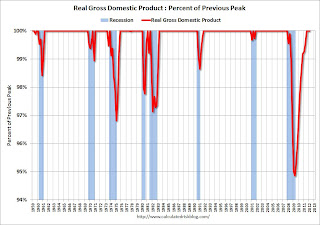 Click on graph for larger image.
Click on graph for larger image.
This graph is for real GDP through Q1 2012. Real GDP returned to the pre-recession peak in Q3 2011, and has been at new post recession highs for three consecutive quarters.
At the worst point, real GDP was off 5.1% from the 2007 peak.
 Real GDP has performed better than other indicators ...
Real GDP has performed better than other indicators ...
This graph shows real personal income less transfer payments as a percent of the previous peak through February (March data will be released Monday).
This measure was off 10.7% at the trough.
Real personal income less transfer payments is still 4.2% below the previous peak.
 The third graph is for industrial production through March.
The third graph is for industrial production through March.
Industrial production was off over 17% at the trough, and has been one of the stronger performing sectors during the recovery.
However industrial production is still 4.1% below the pre-recession peak.
 The final graph is for employment. This is similar to the graph I post every month comparing percent payroll jobs lost in several recessions.
The final graph is for employment. This is similar to the graph I post every month comparing percent payroll jobs lost in several recessions.
Payroll employment is still 3.8% below the pre-recession peak.
All of these indicators collapsed in 2008 and early 2009, and only real GDP is back to the pre-recession peak. It is possible that industrial production will be back to the pre-recession peak in early 2013, but employment and personal income less transfer payments have a long way to go.
Yesterday:
• Summary for Week ending April 27th
• Schedule for Week of April 29th
• The upward slope of Real House Prices
Saturday, April 28, 2012
The upward slope of Real House Prices
by Calculated Risk on 4/28/2012 04:14:00 PM
A year ago, Dave Altig asked Just how out of line are house prices?. Dr. Altig's post featured both a price-to-rent graph and a real house price graph originally from the NY Times based on Professor Robert Shiller's work.
The price-to-rent ratio graph Dr Altig presented seemed to show that house prices were getting back to normal, but the graph based on Professor Shiller's work seemed to suggest that house prices could fall much further. Below is an updated graph from Shiller through Q4 2011.
The Shiller graph has suggested to many observers that house prices track inflation (i.e. that house prices adjusted for inflation are stable - except for bubbles). Last year I pointed out the slope depends on the data series used, and that if Professor Shiller had used either Corelogic or the Freddie Mac house prices series, before Case-Shiller was available, there would a greater upward slope to his graph.
An upward slope to real prices makes sense to me as I've argued before: "In many areas - if the population is increasing - house prices increase slightly faster than inflation over time, so there is an upward slope for real prices."
 Click on graph for larger image in new window.
Click on graph for larger image in new window.
This is the updated graph from Professor Shiller.
For the underlying data for the NY Times graphic, please see Professor Shiller's Irrational Exuberance website.
It is important to realize that Professor Shiller used the quarterly Case-Shiller National index starting in 1987. From 1975 through 1986 he used what is now called the FHFA index. He used other price indexes in earlier periods.
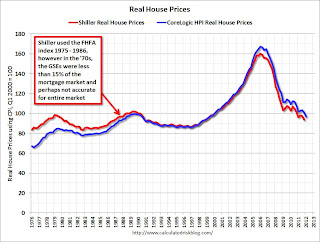 The second graph shows the National Case-Shiller real prices and the CoreLogic HPI real prices (adjusted for CPI just like Shiller). For Q1, I used the February Corelogic index value.
The second graph shows the National Case-Shiller real prices and the CoreLogic HPI real prices (adjusted for CPI just like Shiller). For Q1, I used the February Corelogic index value.
The FHFA index used by Shiller was based on a small percentage of transactions back in the '70s. If we look at the CoreLogic index instead, there is a clear upward slope to real house prices.
If Professor Shiller had used the Freddie Mac quarterly index back to 1970 (instead of the PHCPI), there would be more of an upward slope to his graph too. So it is important to understand that for earlier periods the data is probably less accurate.
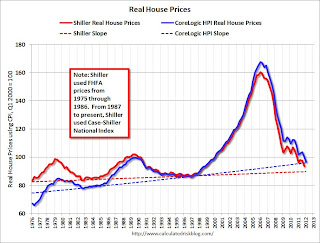 The third graph shows the upward slope for both real price indexes. Even the Shiller "Irrational Exuberance" real price index has an upward slope (about 0.5% per year) - and the CoreLogic upward slope is steeper (about 1.5% per year).
The third graph shows the upward slope for both real price indexes. Even the Shiller "Irrational Exuberance" real price index has an upward slope (about 0.5% per year) - and the CoreLogic upward slope is steeper (about 1.5% per year).
Right now the real CoreLogic HPI is only slightly above the trend line (it could overshoot), and the Case-Shiller national index will probably be just above the trend line when the Q1 data is released.
This would suggest nominal prices are at the bottom (and real prices are close too). This is one reason I think the Case-Shiller and Corelogic house prices indexes probably stopped falling, NSA, in March 2012 (the March data will be released next month).
Earlier:
• Summary for Week ending April 27th
• Schedule for Week of April 29th
Schedule for Week of April 29th
by Calculated Risk on 4/28/2012 01:02:00 PM
Earlier:
• Summary for Week Ending April 27th
The key report for this week will be the April employment report to be released on Friday, May 4th. Other key reports include the ISM manufacturing index and vehicle sales on Tuesday, and the ISM non-manufacturing (service) index on Thursday.
In Europe, the ECB meets on Thursday, and France and Greece hold elections next Sunday, May 6th.
8:30 AM ET: Personal Income and Outlays for March. The consensus is for a 0.3% increase in personal income in March, and a 0.4% increase in personal spending, and for the Core PCE price index to increase 0.2%.
9:45 AM: Chicago Purchasing Managers Index for April. The consensus is for a decrease to 60.8, down from 62.2 in March.
10:00 AM: Q1 Housing Vacancies and Homeownership report from the Census Bureau. As a reminder: Be careful with the Housing Vacancies and Homeownership report. This report is frequently mentioned by analysts and the media to track the homeownership rate, and the homeowner and rental vacancy rates. However, based on the initial evaluation, it appears the vacancy rates are too high.
2:00 PM: The April 2012 Senior Loan Officer Opinion Survey on Bank Lending Practices from the Federal Reserve.
All day: Light vehicle sales for April. Light vehicle sales are expected to increase to 14.4 million from 14.3 million in March (Seasonally Adjusted Annual Rate).
 This graph shows light vehicle sales since the BEA started keeping data in 1967. The dashed line is the March sales rate.
This graph shows light vehicle sales since the BEA started keeping data in 1967. The dashed line is the March sales rate. TrueCar is forecasting:
The April 2012 forecast translates into a Seasonally Adjusted Annualized Rate (SAAR) of 14.6 million new car sales, up from 13.2 million in April 2011 and up from 14.4 million in March 2012Edmund.com is forecasting:
April auto sales will continue at the strong pace set in the first quarter for an estimated Seasonally Adjusted Annual Rate (SAAR) this month of 14.4 million light vehicles
 10:00 AM ET: ISM Manufacturing Index for April.
10:00 AM ET: ISM Manufacturing Index for April. Here is a long term graph of the ISM manufacturing index. The consensus is for a slight decrease to 53.0 from 53.4 in March.
10:00 AM: Construction Spending for March. The consensus is for a 0.5% increase in construction spending.
7:00 AM: The Mortgage Bankers Association (MBA) will release the mortgage purchase applications index. This index has been weak this year, although this does not include all the cash buyers.
8:15 AM: The ADP Employment Report for April. This report is for private payrolls only (no government). The consensus is for 178,000 payroll jobs added in April, down from the 209,000 reported last month.
10:00 AM: Manufacturers' Shipments, Inventories and Orders (Factory Orders) for March. The consensus is for a 1.6% decrease in orders.
8:30 AM: The initial weekly unemployment claims report will be released. The consensus is for claims to decline to 378,000 from 388,000 last week.
9:00 AM: Ceridian-UCLA Pulse of Commerce Index™ This is the diesel fuel index for April (a measure of transportation).
 10:00 AM: ISM non-Manufacturing Index for April. The consensus is for a decrease to 55.9 from 56.0 in March. Note: Above 50 indicates expansion, below 50 contraction.
10:00 AM: ISM non-Manufacturing Index for April. The consensus is for a decrease to 55.9 from 56.0 in March. Note: Above 50 indicates expansion, below 50 contraction.This graph shows the ISM non-manufacturing index (started in January 2008) and the ISM non-manufacturing employment diffusion index.
10:00 AM: Trulia Price & Rent Monitors for April. This is the new index from Trulia that uses asking prices adjusted both for the mix of homes listed for sale and for seasonal factors.
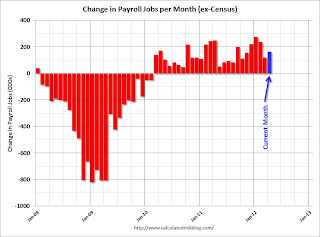 8:30 AM: Employment Report for April. The consensus is for an increase of 165,000 non-farm payroll jobs in April, up from the 120,000 jobs added in March.
8:30 AM: Employment Report for April. The consensus is for an increase of 165,000 non-farm payroll jobs in April, up from the 120,000 jobs added in March.The consensus is for the unemployment rate to remain unchanged at 8.2%.
This second employment graph shows the percentage of payroll jobs lost during post WWII recessions through March.
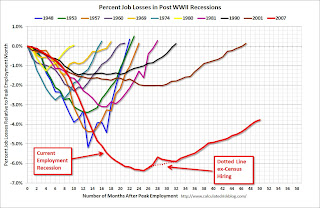 The economy has added 3.58 million jobs since employment bottomed in February 2010 (4.05 million private sector jobs added, and 474 thousand public sector jobs lost).
The economy has added 3.58 million jobs since employment bottomed in February 2010 (4.05 million private sector jobs added, and 474 thousand public sector jobs lost).There are still 4.8 million fewer private sector jobs now than when the recession started in 2007. (5.2 million fewer total nonfarm jobs).
Summary for Week ending April 27th
by Calculated Risk on 4/28/2012 08:05:00 AM
The GDP report was weaker than expected with 2.2% real GDP growth annualized in Q1 (expectations were for 2.5%). This is disappointing growth, but final demand was a little better than overall GDP. Personal consumption expenditures increased at a 2.9% annual rate in Q1, and residential investment (RI) increased at a 19.1% annual rate. Weather probably boosted PCE and RI - and PCE growth at this rate is not sustainable without more income growth - but this was still decent.
Naturally most of the GDP commentary was pretty negative, but I was a little more sanguine. I expect some of the drag to diminish over the next couple of quarters - as an example, investment in non-residential structures was negative in Q1, however, based on the architecture billing index, I expect the drag from other non-residential categories (offices, malls) to end mid-year. And there was another negative contribution from government spending at all levels. However, it appears the drag from state and local governments will end mid-year (after declining for almost 3 years).
A bright spot - and perhaps the key story - is that residential investment is continuing to increase, and I expect this to continue all year (although the recovery in RI will still be sluggish compared to previous recoveries). Since RI is the best leading indicator for the economy, this suggests no recession this year. Still, overall, this was a weak GDP report.
The new home sales report for March was solid and is further confirmation that the recovery for the housing industry has started. New home sales are up about 17% from the weakest three month period during the housing bust. That is a significant improvement, even if the absolute levels are still very low. The debate is now about the strength of the recovery, not whether there is a recovery. My view is housing will remain sluggish for some time, and I expect 2012 to be another historically weak year, but better than 2011.
Another key report was the Case-Shiller house price index for February. This showed house prices fell to new post-bubble lows (I expect further declines in the March report), but we are starting to see some improvement in the year-over-year change. House prices are important for the economy, and I'm watching closely for signs that prices have stopped falling.
The NMHC Apartment index showed further tightening (suggesting falling vacancy rates and rising rents), and the consumer sentiment index increased. For manufacturing, the Richmond Fed index increased, however the Kansas City Fed manufacturing index showed slower growth.
Here is a summary in graphs:
• Real GDP increased at 2.2% annual rate in Q1

Click on graph for larger image.
The GDP report was weaker than expected, however, on a positive note, final demand was decent. Personal consumption expenditures increased at a 2.9% annual rate in Q1, and residential investment increased at a 19.1% annual rate. Weather probably provided a boost to GDP - and PCE growth at this rate is not sustainable without more income growth - but this was still decent.
 Residential Investment as a percent of GDP is still near record lows, but it is increasing. Usually RI bounces back quickly following a recession, but this time there is a wide bottom because of the excess supply of existing vacant housing units.
Residential Investment as a percent of GDP is still near record lows, but it is increasing. Usually RI bounces back quickly following a recession, but this time there is a wide bottom because of the excess supply of existing vacant housing units.
Last year the increase in RI was mostly from multifamily and home improvement investment. Now the increase is probably from most categories including single family. I'll break down Residential Investment (RI) into components after the GDP details are released this coming week.
• New Home Sales in March at 328,000 Annual Rate
 The Census Bureau reports New Home Sales in March were at a seasonally adjusted annual rate (SAAR) of 328 thousand. This was down from a revised 353 thousand SAAR in February (revised up sharply from 313 thousand). December and January were revised up too.
The Census Bureau reports New Home Sales in March were at a seasonally adjusted annual rate (SAAR) of 328 thousand. This was down from a revised 353 thousand SAAR in February (revised up sharply from 313 thousand). December and January were revised up too.
This graph shows New Home Sales vs. recessions since 1963. The dashed line is the current sales rate.
Starting in 1973 the Census Bureau broke inventory down into three categories: Not Started, Under Construction, and Completed.
 This graph shows the three categories of inventory starting in 1973.
This graph shows the three categories of inventory starting in 1973.
The inventory of completed homes for sale was at a record low 48,000 units in March. The combined total of completed and under construction is at the lowest level since this series started.
Even though sales are still very low, new home sales have clearly bottomed. New home sales have averaged 335 thousand SAAR over the last 5 months, after averaging under 300 thousand for the previous 18 months. All of the recent revisions have been up too. This was a solid report and above the consensus forecast.
• Case Shiller: House Prices fall to new post-bubble lows in February NSA
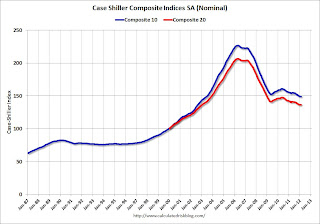 S&P/Case-Shiller released the monthly Home Price Indices for February (a 3 month average of December, January and February).
S&P/Case-Shiller released the monthly Home Price Indices for February (a 3 month average of December, January and February).The first graph shows the nominal seasonally adjusted Composite 10 and Composite 20 indices (the Composite 20 was started in January 2000).
The Composite 10 index is off 34.2% from the peak, and up 0.2% in February (SA). The Composite 10 is at a new post bubble low Not Seasonally Adjusted.
The Composite 20 index is off 33.9% from the peak, and up 0.1% (SA) from January. The Composite 20 is also at a new post-bubble low NSA.
The second graph shows the price declines from the peak for each city included in S&P/Case-Shiller indices.
 Prices increased (SA) in 12 of the 20 Case-Shiller cities in February seasonally adjusted (only 3 cities increased NSA). Prices in Las Vegas are off 61.7% from the peak, and prices in Dallas only off 8.2% from the peak.
Prices increased (SA) in 12 of the 20 Case-Shiller cities in February seasonally adjusted (only 3 cities increased NSA). Prices in Las Vegas are off 61.7% from the peak, and prices in Dallas only off 8.2% from the peak.The NSA indexes are at new post-bubble lows - and the NSA indexes will continue to decline in March (this report was for the three months ending in February).
• Real House Prices and Price-to-Rent Ratio at late '90s Levels
Case-Shiller, CoreLogic and others report nominal house prices. It is also useful to look at house prices in real terms (adjusted for inflation) and as a price-to-rent ratio.
 This graph shows the quarterly Case-Shiller National Index SA (through Q4 2011), and the monthly Case-Shiller Composite 20 SA and CoreLogic House Price Indexes (through February) in real terms (adjusted for inflation using CPI less Shelter). Note: some people use other inflation measures to adjust for real prices.
This graph shows the quarterly Case-Shiller National Index SA (through Q4 2011), and the monthly Case-Shiller Composite 20 SA and CoreLogic House Price Indexes (through February) in real terms (adjusted for inflation using CPI less Shelter). Note: some people use other inflation measures to adjust for real prices.In real terms, the National index is back to Q4 1998 levels, the Composite 20 index is back to January 2000, and the CoreLogic index back to May 1999.
In real terms, all appreciation in the '00s is gone.
In October 2004, Fed economist John Krainer and researcher Chishen Wei wrote a Fed letter on price to rent ratios: House Prices and Fundamental Value. Kainer and Wei presented a price-to-rent ratio using the OFHEO house price index and the Owners' Equivalent Rent (OER) from the BLS.
 Here is a similar graph using the Case-Shiller National, Composite 20 and CoreLogic House Price Indexes.
Here is a similar graph using the Case-Shiller National, Composite 20 and CoreLogic House Price Indexes.This graph shows the price to rent ratio (January 1998 = 1.0).
On a price-to-rent basis, the Case-Shiller National index is back to October 1998 levels, the Composite 20 index is back to February 2000 levels, and the CoreLogic index is back to June 1999.
In real terms - and as a price-to-rent ratio - prices are mostly back to late 1990s or early 2000 levels.
• ATA Trucking index Increased 0.2% in March
 From ATA: ATA Truck Tonnage Index Up 0.2% in March
From ATA: ATA Truck Tonnage Index Up 0.2% in MarchHere is a long term graph that shows ATA's For-Hire Truck Tonnage index.
The dashed line is the current level of the index. The index is above the pre-recession level and up 2.7% year-over-year. More sluggish growth.
• NMHC Apartment Survey: Market Conditions Tighten in Q1 2012

From the National Multi Housing Council (NMHC): Market Conditions Improve For Apartment Industry
This graph shows the quarterly Apartment Tightness Index. Any reading above 50 indicates tightening from the previous quarter. The index has indicated tighter market conditions for the last nine quarters and suggests falling vacancy rates and or rising rents.
This fits with the recent Reis data showing apartment vacancy rates fell in Q1 2012 to 4.9%, down from 5.2% in Q4 2011, and 9.0% at the end of 2009. This is the lowest vacancy rate in the Reis survey in over 10 years.
This survey indicates demand for apartments is still strong. And even though multifamily starts increased in 2011, completions of apartments were near record lows - so supply was constrained. There will be more completions in 2012, but it looks like another strong year for the apartment industry.
• Consumer Sentiment increases slightly in April to 76.4
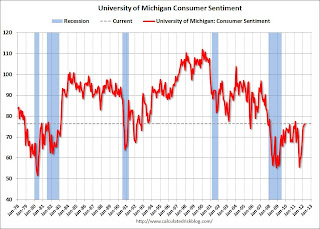 The final Reuters / University of Michigan consumer sentiment index for April increased slightly to 76.4, up from the preliminary reading of 75.7, and up from the March reading of 76.2.
The final Reuters / University of Michigan consumer sentiment index for April increased slightly to 76.4, up from the preliminary reading of 75.7, and up from the March reading of 76.2.This was above the consensus forecast of 75.7. Overall sentiment is still fairly weak - probably due to a combination of the high unemployment rate, high gasoline prices and sluggish economy - however sentiment has rebounded from the decline last summer.
• Other Economic Stories ...
• NAR: Pending home sales index increased in March
• FOMC Statement: Economy "expanding moderately"
• FOMC Forecasts and Bernanke Press Conference
Friday, April 27, 2012
Lack of Demand
by Calculated Risk on 4/27/2012 11:05:00 PM
Just a reminder of why companies aren't investing more ... from Bruno Navarro at CNBC: Why Businesses Aren't Investing in the US: CEO
Businesses aren’t investing in the United States because of a lack of consumer demand, International Paper CEO John Faraci said Friday.It really isn't hard to understand [why certain companies aren't investing - these companies have adequate capacity to meet expected demand]. [added]
“I think this was all about consumer spending and demand. You know, the problem we have is there’s inadequate demand to create jobs. We know how to respond when there is demand,” he said ...
“Productivity has obviously been very good, so we’re creating more capacity with less resources. But at the end of the day, this is really about responding to demand, whether it’s automobiles or packaging products we make for a whole variety of industries and end users,”
Bank Failure #22: Palm Desert National Bank, Palm Desert, California
by Calculated Risk on 4/27/2012 09:20:00 PM
Crawling along the desert
Deposits ... Cash ... Help!
by Soylent Green is People
From the FDIC: Pacific Premier Bank, Costa Mesa, California, Assumes All of the Deposits of Palm Desert National Bank, Palm Desert, California
As of December 31, 2011, Palm Desert National Bank had approximately $125.8 million in total assets and $122.8 million in total deposits. ... The FDIC estimates that the cost to the Deposit Insurance Fund (DIF) will be $20.1 million. ... Palm Desert National Bank is the 22nd FDIC-insured institution to fail in the nation this year, and the first in California.That makes five today ... and we haven't seen a California bank fail since last September.
Bank Failures #18 through #21 in 2012
by Calculated Risk on 4/27/2012 06:28:00 PM
The merciless scythe wielded
Detritus voided
by Soylent Green is People
From the FDIC: FDIC Creates a Deposit Insurance National Bank of Eastern Shore to Protect Insured Depositors of Bank of the Eastern Shore, Cambridge, Maryland
As of December 31, 2011, Bank of the Eastern Shore had $166.7 million in total assets and $154.5 million in total deposits. ... The cost to the FDIC's Deposit Insurance Fund is estimated to be $41.8 million. Bank of the Eastern Shore is the 18th FDIC-insured institution to fail in the nation this year, and the first in Maryland.From the FDIC: Sonabank, McLean, Virginia, Assumes All of the Deposits of HarVest Bank of Maryland, Gaithersburg, Maryland
As of December 31, 2011, HarVest Bank of Maryland had approximately $164.3 million in total assets and $145.5 million in total deposits. ... The FDIC estimates that the cost to the Deposit Insurance Fund (DIF) will be $17.2 million. ... HarVest Bank of Maryland is the 19th FDIC-insured institution to fail in the nation this year, and the second in Maryland.From the FDIC: Great Southern Bank, Reeds Spring, Missouri, Assumes All of the Deposits of Inter Savings Bank, fsb D/B/A Interbank, fsb, Maple Grove, Minnesota
As of December 31, 2011, InterBank, fsb had approximately $481.6 million in total assets and $473.0 million in total deposits. ... The FDIC estimates that the cost to the Deposit Insurance Fund (DIF) will be $117.5 million. ... InterBank, fsb is the 20th FDIC-insured institution to fail in the nation this year, and the third in Minnesota.From the FDIC: First Federal Bank, Charleston, South Carolina, Assumes All of the Deposits of Plantation Federal Bank, Pawleys Island, South Carolina
As of December 31, 2011, Plantation Federal Bank had approximately $486.4 million in total assets and $440.5 million in total deposits. ... The FDIC estimates that the cost to the Deposit Insurance Fund (DIF) will be $76.0 million. ... Plantation Federal Bank is the 21st FDIC-insured institution to fail in the nation this year, and the first in South Carolina.Four down so far!
WSJ on Housing: "Bidding wars are back"
by Calculated Risk on 4/27/2012 03:03:00 PM
Earlier today from Nick Timiraos at the WSJ: Stunned Home Buyers Find the Bidding Wars Are Back
A new development is catching home buyers off guard as the spring sales season gets under way: Bidding wars are back.Housing economist Tom Lawler sent me this comment on Timiraos' article:
...
From California to Florida, many buyers are increasingly competing for the same house. Unlike the bidding wars that typified the go-go years and largely reflected surging sales, today's are a result of supply shortages.
...
"We very much believe we've hit bottom," said Ivy Zelman, chief executive of a research firm, who was among the first to warn of a downturn seven years ago.
...
The Wall Street Journal's quarterly survey found that the inventory of homes listed for sale declined sharply in all 28 markets tracked. ...
Increased competition is frustrating buyers and their agents. "We're writing a record number of offers, but we're not seeing a record number of closings and that's because it's so competitive," said Glenn Kelman, chief executive of real-estate brokerage Redfin Corp. in Seattle with offices in 14 states.
The above [article] highlights a trend many realtors have been talking about – in many parts of the country homes listed for sale are not just receiving multiple offers, but are selling above list price. In many markets the “catalysts” for this “new” trend are sharply lower inventories of homes listed for sale; moderate increases in “traditional” home buying, spurred by low interest rates, rising rents, and a growing view that home prices may have finally stopped declining; and intense demand by investors for “distressed” properties they plan to rent out. Of course, the article cautions that housing markets face “headwinds” – still high (but much lower) REO inventories, still high (but somewhat lower) numbers of mortgages either seriously delinquent or in foreclosure, still lots of current homeowners “underwater,” and historically “sorta tough” mortgage lending standards. Still, the article is consistent with local realtor reports and other incoming data that home prices in many parts of the country are rebounding, and this trend should be reflected in many widely followed home price indexes a few months from now.
Q1 GDP: Comments and Investment
by Calculated Risk on 4/27/2012 12:11:00 PM
The GDP report was weaker than expected, however, on a positive note, final demand was decent. Personal consumption expenditures increased at a 2.9% annual rate in Q1, and residential investment increased at a 19.1% annual rate. Weather probably provided a boost to GDP - and PCE growth at this rate is not sustainable without more income growth - but this was still decent.
Investment in equipment and software slowed down to a 1.7% annual rate in Q1, but this slowdown is probably temporary. The largest quarterly contributions to GDP from equipment and software in this recovery have probably already happened, but I expect equipment investment to continue at a reasonable pace.
And investment in non-residential structures was negative in Q1. The details will be released next week, but this probably means investment in energy and power structures slowed in Q1 (this has been the main driver for non-residential structure investment over the last couple of years). However, based on the architecture billing index, I expect the drag from other non-residential categories (offices, malls) to end mid-year, so this negative contribution will probably end.
And there was another negative contribution from government spending at all levels. However, it appears the drag from state and local governments will end mid-year (after declining for almost 3 years).
A negative was that some of the increase in GDP was related to a positive contribution from changes in private inventories (this added 0.59 percentage points to Q1 GDP). This will probably be a drag for a quarter or two (swings in inventory are normal).
Overall this was a weak report, but it appears some of the drags will diminish over the course of the year - and that is a positive.
The following graph shows the contribution to GDP from residential investment, equipment and software, and nonresidential structures (3 quarter centered average). This is important to follow because residential investment tends to lead the economy, equipment and software is generally coincident, and nonresidential structure investment trails the economy.
For the following graph, red is residential, green is equipment and software, and blue is investment in non-residential structures. So the usual pattern - both into and out of recessions is - red, green, blue.
The dashed gray line is the contribution from the change in private inventories.
 Click on graph for larger image.
Click on graph for larger image.
Residential Investment (RI) made a positive contribution to GDP in Q1 for the fourth consecutive quarter. Usually residential investment leads the economy, but that didn't happen this time because of the huge overhang of existing inventory, but now RI is contributing. Sure - some of the boost could be weather related, but RI has clearly bottomed.
The contribution from RI will probably continue to be sluggish compared to previous recoveries, but the ongoing positive contribution to GDP is a significant story.
Equipment and software investment has made a positive contribution to GDP for eleven straight quarters (it is coincident). However the contribution from equipment and software investment in Q1 was the weakest since the recovery started.
The contribution from nonresidential investment in structures was negative in Q1. Nonresidential investment in structures typically lags the recovery, however investment in energy and power has masked the ongoing weakness in office, mall and hotel investment (the underlying details will be released next week).
 Residential Investment as a percent of GDP is still near record lows, but it is increasing. Usually RI bounces back quickly following a recession, but this time there is a wide bottom because of the excess supply of existing vacant housing units.
Residential Investment as a percent of GDP is still near record lows, but it is increasing. Usually RI bounces back quickly following a recession, but this time there is a wide bottom because of the excess supply of existing vacant housing units.
Last year the increase in RI was mostly from multifamily and home improvement investment. Now the increase is probably from most categories including single family. I'll break down Residential Investment (RI) into components after the GDP details are released this coming week. Note: Residential investment (RI) includes new single family structures, multifamily structures, home improvement, broker's commissions, and a few minor categories.
 The last graph shows non-residential investment in structures and equipment and software.
The last graph shows non-residential investment in structures and equipment and software.
Equipment and software investment had been increasing sharply, however the growth slowed over the last two quarters.
Non-residential investment in structures decreased in Q1 and is still near record lows as a percent of GDP. The recent small increase has come from investment in energy and power. I'll add details for investment in offices, malls and hotels next week.
The key story is that residential investment is continuing to increase, and I expect this to continue all year (although the recovery in RI will be sluggish compared to previous recoveries). Since RI is the best leading indicator for the economy, this suggests no recession this year.
Earlier ...
• Real GDP increased 2.2% annual rate in Q1
Consumer Sentiment increases slightly in April to 76.4
by Calculated Risk on 4/27/2012 09:55:00 AM

Click on graph for larger image.
The final Reuters / University of Michigan consumer sentiment index for April increased slightly to 76.4, up from the preliminary reading of 75.7, and up from the March reading of 76.2.
This was above the consensus forecast of 75.7. Overall sentiment is still fairly weak - probably due to a combination of the high unemployment rate, high gasoline prices and sluggish economy - however sentiment has rebounded from the decline last summer.
Real GDP increased 2.2% annual rate in Q1
by Calculated Risk on 4/27/2012 08:44:00 AM
Real gross domestic product -- the output of goods and services produced by labor and property located in the United States -- increased at an annual rate of 2.2 percent in the first quarter of 2012 (that is, from the fourth quarter to the first quarter), according to the "advance" estimate released by the Bureau of Economic Analysis.
The increase in real GDP in the first quarter primarily reflected positive contributions from personal consumption expenditures (PCE), exports, private inventory investment, and residential fixed investment that were partly offset by negative contributions from federal government spending, nonresidential fixed investment, and state and local government spending. Imports, which are a subtraction in the calculation of GDP, increased.
The deceleration in real GDP in the first quarter primarily reflected a deceleration in private inventory investment and a downturn in nonresidential fixed investment that were partly offset by accelerations in PCE and in exports.

Click on graph for larger image.
A few key numbers:
• Real personal consumption expenditures increased 2.9 percent in the first quarter, compared with an increase of 2.1 percent in the fourth.
• Investment growth slowed, except residential investment: "Real nonresidential fixed investment decreased 2.1 percent in the first quarter, in contrast to an increase of 5.2 percent in the fourth. Nonresidential structures decreased 12.0 percent, compared with a decrease of 0.9 percent. Equipment and software increased 1.7 percent, compared with an increase of 7.5 percent. Real residential fixed investment increased 19.1 percent, compared with an increase of 11.6 percent."
• Government spending continued to be a drag at all levels, but at a slower pace: "Real federal government consumption expenditures and gross investment decreased 5.6 percent in the first quarter, compared with a decrease of 6.9 percent in the fourth. ... Real state and local government consumption expenditures and gross investment decreased 1.2 percent, compared with a decrease of 2.2 percent."
This was below expectations. I'll have more on GDP later ...


